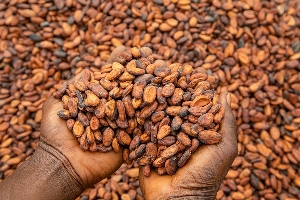The global cocoa market is buckling under the strain of unprecedented shortages.
A once-unimaginable rally that upended physical trading is now filtering rapidly through to the futures market. Prices that have more than doubled in just three months are forcing traders, processors and chocolate makers to stump up more cash to cover their trades or head for the exit.
That’s raising the specter of company failures like the ones that plagued European utilities during the recent energy crisis, when gas prices spiraled out of control and governments were forced to bail them out. There are fears it could be worse — some traders are even alluding to a nickel-type meltdown that rattled the London Metal Exchange.
“It’s hard to understand the magnitude of the price rise,” said Pam Thornton, a veteran commodity trader at Nightingale Investment Management, who’s best know for her role at former cocoa hedge fund Armajaro Asset Management. “When you have moves of this magnitude, there are usually casualties and I’m amazed I haven’t heard of any yet.”
Cocoa futures have surged as poor harvests in West Africa, where most of the world’s beans are grown, sparked a third year of shortages. There’s a risk the crunch could be long-lasting, with climate change and crop disease ravaging trees and concerns mounting that production in Ivory Coast and Ghana has entered a period of structural decline.
There are already signs of stress building across the industry.
Switzerland’s Barry Callebaut AG, the largest maker of bulk chocolate, in January said it expected “an industry wide impact on working capital requirements.” It said it addressed the concern by issuing 600 million Swiss francs ($663 million) in bonds to refinance securities due in May, as well as increasing a credit line and securing another loan.
While Barry Callebaut’s shares have dropped by about a third in the past year, investor Artisan Partners Asset Management Inc. has just increased its stake, expressing longer-term confidence in the company.
Acomo NV, owner of Dutch trader Tradin Organic, said last year’s earnings were “materially impacted by the unprecedented increase in cocoa prices, resulting in lower demand and hedging losses.” Chocolate companies are also feeling the pinch, with BNP Paribas Exane downgrading Hershey Co. due to surging costs.
Bean Shortages
Scarce supplies first sparked a race to secure beans where they’re grown. In Ivory Coast, many traders and processors rushed to source supplies by paying farmers more than the prices set by the government. Others have turned to smaller producers like Ecuador and Indonesia, but it won’t be enough.
Barry Callebaut expects a deficit of about 500,000 tons this season, equal to about a 10th of the global market. The firm, a supplier to the likes of Mars Inc. and Nestle SA, predicts another shortfall of 150,000 tons next season.
The shortages are roiling the futures market. As prices rise, traders with short positions — including those who’ve sold futures to hedge against physical holdings — have to come up with more money to pay margin calls, which work as an insurance policy to cover potential losses. Those who can’t are forced to buy back contracts, pushing up prices further and creating a vicious circle.
That’s exactly what happened in the gas market when Russia began restricting supplies to Europe. Prices spiraled out of control and companies started to fail one after another. German utilities including Uniper SE and the former European trading and supply unit of Gazprom PJSC had to be rescued.
In nickel, a runaway short squeeze centered on the world’s top producer in 2022 created so much market stress that it put others at risk of failing too. But unlike the LME, Intercontinental Exchange Inc. is unlikely to intervene and halt cocoa trading to protect those vulnerable in the market.
ICE has however taken several steps to tame the rally and keep the London and New York markets orderly. The bourse increased margins several times this year and reduced the threshold for when market players need to disclose more information about their positions.
In London, where Ivory Coast and Ghana hedge their sales, the exchange is gradually cutting the amount traders can buy through its market. The so-called delivery limit is going from 75,000 tons in May to 50,000 tons in July, and down progressively until it reaches 25,000 tons for the December contract onward.
“It is a moment of great uncertainty, and the exchange measures are to avoid the market from being even more squeezed,” said Leonardo Rossetti, an analyst at brokerage StoneX.
Exchange Role
ICE Futures Europe President Christopher Rhodes said the cocoa market is serving its function as a venue to manage price risk, and pointed to speculators curbing their positions.
“Derivatives markets facilitate price discovery, allow customers to manage their risk, and serve as a buyer and seller of last resort,” he said in a statement. “These principles are especially important when the underlying demand and supply fundamentals change, as we are seeing in cocoa.”
With beans harder to come by, agricultural trading giant Cargill Inc. recently turned to exchange supplies to source cocoa. The US merchant took delivery of 75,000 tons, the maximum allowed, when the March contract expired in London.
“We do intend to use a part of those beans to offset some of the shortages of fresh cocoa from our suppliers in West Africa,” said Job Leuning, Cargill’s head of cocoa trading. “We are keen to continue offering our customers the cocoa and chocolate products that they need in 2024.”
Cocoa continued to soar after Cargill took delivery and if the company does use the beans, it will further pressure already low exchange-certified stockpiles.
Replenishing inventories won’t be easy as new European Union rules due to kick in at year-end will require companies to show crops haven’t come from deforested land — something the industry is still struggling with how to prove.
The EU has faced calls to delay the deforestation regulation and cocoa futures could drop significantly if the deadline is pushed back. Some traders also say that the rally to more than $10,000 a ton — a higher price than copper — may be enough to curb demand.
Tough Environment
For now, the high costs are hurting processors, with factories in West Africa slowing down or shutting. Blommer Chocolate Co. is closing its 85-year-old Chicago chocolate plant as the facility is no longer efficient. Barry Callebaut, which began a reorganization before the rally took off, has cut 18% of its workforce. It plans to close a German factory and a facility in Malaysia.
For everyone in the market, the spike higher has been accompanied by huge volatility, with a gauge of price swings near the highest in more than a decade.
“The cocoa market is currently not a confectioner’s comfort zone,” said Tristan Fletcher, chief executive officer at ChAI, a platform that uses AI to analyze commodity markets. “It’s a battleground for those with a taste for volatility.”
Focus is now turning to West Africa’s new harvest, though supplies will probably only start to ease next year after farmers have had time to react to higher prices and improve production. Another key question is how much supply is being held back in anticipation of the rally continuing.
Until more supplies arrive or demand craters, the industry should brace for a tough market and potentially higher prices — especially with liquidity in the futures market drying up.
“All the dealers I talk to, somewhere in the middle of the conversation, I hear that the market is broken,” Nightingale’s Thornton said. “I am talking about the overall market being broken, especially physical trading as counterparty risk and financing has become impossible to manage.”
Business News of Thursday, 28 March 2024
Source: bloomberg.com













